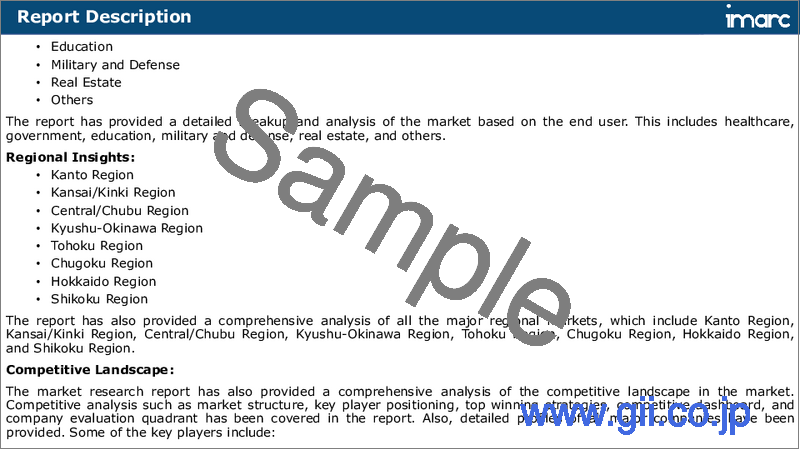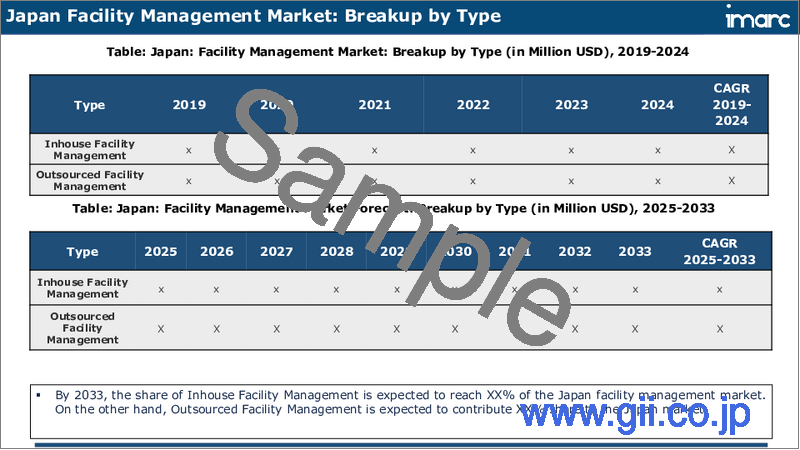|
|
市場調査レポート
商品コード
1729474
日本のファシリティマネジメント市場レポート:タイプ別、提供別、エンドユーザー別、地域別、2025年~2033年Japan Facility Management Market Report by Type (Inhouse Facility Management, Outsourced Facility Management), Offering (Hard FM, Soft FM), End User (Healthcare, Government, Education, Military and Defense, Real Estate, and Others), and Region 2025-2033 |
||||||
カスタマイズ可能
|
|||||||
| 日本のファシリティマネジメント市場レポート:タイプ別、提供別、エンドユーザー別、地域別、2025年~2033年 |
|
出版日: 2025年05月01日
発行: IMARC
ページ情報: 英文 120 Pages
納期: 5~7営業日
|
- 全表示
- 概要
- 目次
日本のファシリティマネジメントの市場規模は2024年に863億4,600万米ドルに達しました。今後、IMARC Groupは、同市場が2033年までに1,657億7,900万米ドルに達し、2025~2033年の成長率(CAGR)は7.5%に達すると予測しています。スペースプランニング、入居管理、持続可能性コンサルティング、ワークプレイス最適化など、本質的なメンテナンスにとどまらない付加価値サービスに対する需要の高まりが、主に市場成長の原動力となっています。
本レポートで扱う主な質問
- 日本のファシリティマネジメント市場はこれまでどのように推移し、今後どのように推移するのか?
- COVID-19が日本のファシリティマネジメント市場に与えた影響は?
- 日本のファシリティマネジメント市場のタイプ別区分は?
- 日本のファシリティマネジメント市場の提供別の区分は?
- 日本のファシリティマネジメント市場のエンドユーザー別の区分は?
- 日本のファシリティマネジメントのバリューチェーンにおける様々なステージとは?
- 日本のファシリティマネジメントの主な促進要因と課題は何か?
- 日本のファシリティマネジメント市場の構造と主要プレーヤーは?
- 日本のファシリティマネジメント市場における競合の程度は?
目次
第1章 序文
第2章 調査範囲と調査手法
- 調査の目的
- ステークホルダー
- データソース
- 市場推定
- 調査手法
第3章 エグゼクティブサマリー
第4章 日本のファシリティマネジメント市場:イントロダクション
- 概要
- 市場力学
- 業界動向
- 競合情報
第5章 日本のファシリティマネジメント市場情勢
- 過去および現在の市場動向(2019~2024年)
- 市場予測(2025~2033年)
第6章 日本のファシリティマネジメント市場:タイプ別内訳
- 社内施設管理
- アウトソーシング施設管理
第7章 日本のファシリティマネジメント市場:提供別内訳
- ハードFM
- ソフトFM
第8章 日本のファシリティマネジメント市場:エンドユーザー別内訳
- ヘルスケア
- 政府
- 教育
- 軍事と防衛
- 不動産
- その他
第9章 日本のファシリティマネジメント市場:競合情勢
- 概要
- 市場構造
- 市場企業のポジショニング
- 主要成功戦略
- 競合ダッシュボード
- 企業評価象限
第10章 主要企業のプロファイル
第11章 日本のファシリティマネジメント市場:業界分析
- 促進要因、抑制要因、機会
- ポーターのファイブフォース分析
- バリューチェーン分析
第12章 付録
Japan facility management market size reached USD 86,346 Million in 2024. Looking forward, IMARC Group expects the market to reach USD 165,779 Million by 2033, exhibiting a growth rate (CAGR) of 7.5% during 2025-2033. The growing demand for value-added services, such as space planning, occupancy management, sustainability consulting, workplace optimization, etc., that go beyond essential maintenance is primarily driving the market growth.
Facility management is an interdisciplinary domain focused on the efficient maintenance and coordination of an organization's physical assets, services, and infrastructure. It entails the amalgamation of people, processes, technology, and physical spaces to guarantee the seamless functioning and optimum efficacy of facilities. Individuals working in facility management oversee a variety of responsibilities such as planning of facilities, upkeep and repair, management of space, ensuring safety and security, managing energy, promoting environmental sustainability, and overseeing vendors. Their role is pivotal in establishing and sustaining secure, operational, and effective workspaces for employees and other stakeholders. Proficient facility management fosters enhanced productivity, monetary savings, reduction in risks, and improved user experiences. This domain requires strategic foresight, proper distribution of resources, and the employment of exemplary practices to synchronize facilities with the aims and objectives of an organization. It also encompasses adherence to regulations, initiatives for sustainability, and the incorporation of technology for automation and informed decision-making based on data.
Japan Facility Management Market Trends:
The Japan facility management industry is experiencing significant growth, driven by the surge in the utilization of smart building technologies. Additionally, smart buildings are incorporated with cutting-edge technologies like sensors, automation systems, and data analytics, thereby facilitating intelligent supervision and regulation of diverse building systems and services. Besides this, the advantages of these smart building solutions are manifold, including heightened energy efficiency, superior space optimization, augmented security and safety, and predictive maintenance capabilities, which is positively influencing the regional market. Moreover, professionals in facility management exploit such technologies to supervise and manage building functions remotely, pinpoint inefficiencies, and undertake proactive maintenance interventions. Apart from this, the amalgamation of facility management methodologies with smart building solutions facilitates the gathering and analysis of real-time data, enabling decisions based on solid data and the execution of anticipatory maintenance strategies. Such integrations contribute to a decrease in operational expenditures, improved comfort and health of occupants, and an increase in the longevity of building assets. Furthermore, with the continual evolution and tightening of regulatory frameworks, organizations are increasingly depending on facility management services to maintain compliance and minimize legal and financial vulnerabilities. This, in turn, is anticipated to bolster the regional market over the forecasted period.
Japan Facility Management Market Segmentation:
- Inhouse Facility Management
- Outsourced Facility Management
- Single FM
- Bundled FM
- Integrated FM
Offering Insights:
- Hard FM
- Soft FM
End User Insights:
- Healthcare
- Government
- Education
- Military and Defense
- Real Estate
- Others
Competitive Landscape:
The market research report has also provided a comprehensive analysis of the competitive landscape in the market. Competitive analysis such as market structure, key player positioning, top winning strategies, competitive dashboard, and company evaluation quadrant has been covered in the report. Also, detailed profiles of all major companies have been provided. Some of the key players include:
- CBRE Group Inc.
- Cushman & Wakefield plc
- ISS A/S
- Jones Lang LaSalle IP Inc.
- Nippon Kanzai Co. Ltd.
Key Questions Answered in This Report:
- How has the Japan facility management market performed so far and how will it perform in the coming years?
- What has been the impact of COVID-19 on the Japan facility management market?
- What is the breakup of the Japan facility management market on the basis of type?
- What is the breakup of the Japan facility management market on the basis of offering?
- What is the breakup of the Japan facility management market on the basis of end user?
- What are the various stages in the value chain of the Japan facility management?
- What are the key driving factors and challenges in the Japan facility management?
- What is the structure of the Japan facility management market and who are the key players?
- What is the degree of competition in the Japan facility management market?
Table of Contents
1 Preface
2 Scope and Methodology
- 2.1 Objectives of the Study
- 2.2 Stakeholders
- 2.3 Data Sources
- 2.3.1 Primary Sources
- 2.3.2 Secondary Sources
- 2.4 Market Estimation
- 2.4.1 Bottom-Up Approach
- 2.4.2 Top-Down Approach
- 2.5 Forecasting Methodology
3 Executive Summary
4 Japan Facility Management Market - Introduction
- 4.1 Overview
- 4.2 Market Dynamics
- 4.3 Industry Trends
- 4.4 Competitive Intelligence
5 Japan Facility Management Market Landscape
- 5.1 Historical and Current Market Trends (2019-2024)
- 5.2 Market Forecast (2025-2033)
6 Japan Facility Management Market - Breakup by Type
- 6.1 Inhouse Facility Management
- 6.1.1 Overview
- 6.1.2 Historical and Current Market Trends (2019-2024)
- 6.1.3 Market Forecast (2025-2033)
- 6.2 Outsourced Facility Management
- 6.2.1 Overview
- 6.2.2 Historical and Current Market Trends (2019-2024)
- 6.2.3 Market Segmentation
- 6.2.3.1 Single FM
- 6.2.3.2 Bundled FM
- 6.2.3.3 Integrated FM
- 6.2.4 Market Forecast (2025-2033)
7 Japan Facility Management Market - Breakup by Offering
- 7.1 Hard FM
- 7.1.1 Overview
- 7.1.2 Historical and Current Market Trends (2019-2024)
- 7.1.3 Market Forecast (2025-2033)
- 7.2 Soft FM
- 7.2.1 Overview
- 7.2.2 Historical and Current Market Trends (2019-2024)
- 7.2.3 Market Forecast (2025-2033)
8 Japan Facility Management Market - Breakup by End User
- 8.1 Healthcare
- 8.1.1 Overview
- 8.1.2 Historical and Current Market Trends (2019-2024)
- 8.1.3 Market Forecast (2025-2033)
- 8.2 Government
- 8.2.1 Overview
- 8.2.2 Historical and Current Market Trends (2019-2024)
- 8.2.3 Market Forecast (2025-2033)
- 8.3 Education
- 8.3.1 Overview
- 8.3.2 Historical and Current Market Trends (2019-2024)
- 8.3.3 Market Forecast (2025-2033)
- 8.4 Military and Defense
- 8.4.1 Overview
- 8.4.2 Historical and Current Market Trends (2019-2024)
- 8.4.3 Market Forecast (2025-2033)
- 8.5 Real Estate
- 8.5.1 Overview
- 8.5.2 Historical and Current Market Trends (2019-2024)
- 8.5.3 Market Forecast (2025-2033)
- 8.6 Others
- 8.6.1 Historical and Current Market Trends (2019-2024)
- 8.6.2 Market Forecast (2025-2033)
9 Japan Facility Management Market - Competitive Landscape
- 9.1 Overview
- 9.2 Market Structure
- 9.3 Market Player Positioning
- 9.4 Top Winning Strategies
- 9.5 Competitive Dashboard
- 9.6 Company Evaluation Quadrant
10 Profiles of Key Players
- 10.1 CBRE Group Inc.
- 10.1.1 Business Overview
- 10.1.2 Services Offered
- 10.1.3 Business Strategies
- 10.1.4 SWOT Analysis
- 10.1.5 Major News and Events
- 10.2 Cushman & Wakefield plc
- 10.2.1 Business Overview
- 10.2.2 Services Offered
- 10.2.3 Business Strategies
- 10.2.4 SWOT Analysis
- 10.2.5 Major News and Events
- 10.3 ISS A/S
- 10.3.1 Business Overview
- 10.3.2 Services Offered
- 10.3.3 Business Strategies
- 10.3.4 SWOT Analysis
- 10.3.5 Major News and Events
- 10.4 Jones Lang LaSalle IP Inc.
- 10.4.1 Business Overview
- 10.4.2 Services Offered
- 10.4.3 Business Strategies
- 10.4.4 SWOT Analysis
- 10.4.5 Major News and Events
- 10.5 Nippon Kanzai Co. Ltd.
- 10.5.1 Business Overview
- 10.5.2 Services Offered
- 10.5.3 Business Strategies
- 10.5.4 SWOT Analysis
- 10.5.5 Major News and Events
11 Japan Facility Management Market - Industry Analysis
- 11.1 Drivers, Restraints and Opportunities
- 11.1.1 Overview
- 11.1.2 Drivers
- 11.1.3 Restraints
- 11.1.4 Opportunities
- 11.2 Porters Five Forces Analysis
- 11.2.1 Overview
- 11.2.2 Bargaining Power of Buyers
- 11.2.3 Bargaining Power of Suppliers
- 11.2.4 Degree of Competition
- 11.2.5 Threat of New Entrants
- 11.2.6 Threat of Substitutes
- 11.3 Value Chain Analysis






